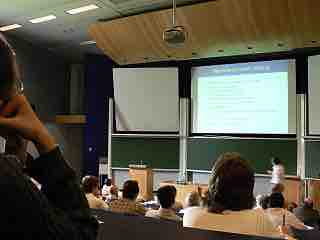The physical context is the setting where the speech occurs. You can prepare for three different contexts--face to face with co-located audience , a speaker with live audience to remote audiences and a speaker with no live audience to different remote locations by video conferencing technology .

Rear Adm. J. Kevin Moran, speaks by video conference to The Center for Aviation Technical Training (CNATT)
Rear Adm. J. Kevin Moran, commander, Naval Personnel Development Command (NPDC) Norfolk, Va., speaks by video conference to The Center for Aviation Technical Training (CNATT)

Auditorium,University of Liège
Auditorium,University of Liège
Physical Context for the Co-Located Audience
The physical context for the co-located audience is the setting or room where you speak. There are a number of questions to consider about the space. Here is a checklist:
- What is the size of the room or other area?
- If outdoors, where is the location, what is the weather, temperature, and noise?
- Is there any significance to the location such as a historic landmark or memorial?
- Is this a special occasion such as holiday celebration or anniversary of an event at the site?
- What is the anticipated size of the audience and the arrangement of seating?
- Will there be a stage, podium or lectern?
- What equipment is available such as microphone, computer, or projection system?
- Will there be an ethernet or wi-fi connection?
- What time of the day will your speech occur, will the audience be awake, or sleepy after eating?
If you are not the only speaker, you want to confirm the order of speaking with the emcee so you know where and when you can get access to any equipment needed for your presentation. Checking out the physical context will allow you to plan so you are not attempting to borrow or move equipment before getting up to speak.
Physical Context for the Combined Co-Located with One or More Secondary Locations
You may find yourself speaking in one primary location with the audio or video of your speech being streamed live to other secondary locations. You will be aware of your primary location but you will not know what is happening in the other locations. When you have a live audience co-located in front of you it will be easier to relate to and respond to the audience and avoid many of the problems associated with delivery by webcam or web conferencing only technology.
Physical Context when Speaking to Remote Locations by Video Conferencing Technology
With videoconferencing you deliver a message to two or more locations by computer mediated communication. You may deliver the speech to another location with no interaction or you may engage in two way interaction with the different locations. In order to video conference you will need access to the basic components:
- Video input: video camera or webcam
- Video output: computer monitor, television or projector for the audience
- Audio input for the speaker: microphones, CD/DVD player, cassette player, or any other source of PreAmp audio outlet
- Audio output for the audience: usually loudspeakers connected with the display monitor or TV
- Data transfer: analog or digital telephone network, LAN or Internet
- Computer: a data processing unit that ties together the other components, does the compressing and decompressing, and initiates and maintains the data linkage via the network.
There are basically two kinds of videoconferencing systems which you may encounter:
- Non-portable are used for large rooms or small dedicated conferencing rooms. They have all required components packaged into a single equipment console.
- Portable systems are available for use with small audiences in small meeting rooms and for video seminars. You can create your own simple system with webcam, microphone, headset or speakers. You can now deliver the message using a broadband internet connection to a small group audience at minimal or no cost.
Since you do not have a live audience in front of you while speaking in this context, there are several issues to address:
- Eye contact: Eye contact plays a large role in large and small group communication. Many video conferencing systems give the impression that the speaker is avoiding eye contact. You may find it necessary to practice with the camera and study how eye contact will be perceived by the remote audience and adjust accordingly.
- Appearance consciousness: A second psychological problem with videoconferencing is being on camera, with the video stream possibly even being recorded. The anxiety may be similar to stage fright but there is a difference since you really do not know how the remote listeners are reacting to you. Check out how you appear by recording a sample of your speech and viewing it to adjust to being "on camera. "
- Signal latency: An increased latency (time lag) larger than about 150–300 ms becomes noticeable and is soon observed as unnatural and distracting. With high bandwidth systems, the latency problem is minimized but you are still well advised to minimize quick moves and rapid gestures while speaking, since some audience members may have slower connections.